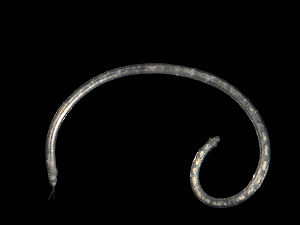Protodriliformia
| Protodriliformia | ||||||||
|---|---|---|---|---|---|---|---|---|

|
||||||||
| Systematics | ||||||||
|
||||||||
| Scientific name | ||||||||
| Protodriliformia | ||||||||
| Struck , Golombek et al., 2015 |
Protodriliformia is the name of a taxon of tiny to small polychaeta (polychaeta) living in the sand gap system of bacteria , which can be found in seas around the world, and which includes the family of Polygordiidae in addition to the Protodrilida .
features
The protodriliformia usually have a transparent to whitish, sometimes yellow, orange or green body, which, depending on the sub-taxon, is 1.6 mm to 10 cm long and at most 1 mm wide and can count up to 200 segments, but which lacks parapodies. At the prostomium there is always a pair of palps (also known as " tentacles ") with a sensory function, which in the Protodrilida are fine and very mobile, in the Polygordiida, however, they are stiff and firm, as well as a pair of nuchal organs . In addition, in both orders there are both blind and species that simply have pigmented eyes. The animals mostly have rows of eyelashes on their belly which are used for locomotion, but their size and shape vary greatly. The Protodriliformia have a pygidium with glue glands that the animals use to attach themselves to sediment grains. A simple, closed blood vessel system with colorless blood is present, but a central heart is missing.
habitat
The Protodriliformia live in the sand gap system, mostly in coarse sediments with larger gaps, because they cannot dig themselves tunnels. Most species graze the bacteria that live on the surface of the grains of sand. The animals move with the help of their belly-side eyelash strips and are able to attach themselves to a grain of sand with the help of their sticky pygidium.
Development cycle
Most Protodriliformia are sexually separated. While there is internal fertilization in the Saccocirridae (with penis and vagina ) and the Protodrilidae (with spermatophores ), in the Polygordiidae the eggs are fertilized in the open sea water. In many species in both orders the gametes are released by tearing the epidermis, but in some species via fallopian tubes. The development usually takes place via a freely swimming trochophora larva, but in Protodriloides with its very large eggs it occurs directly in a cocoon from which finished worms hatch.
Systematics
The taxon Protodriliformia consisting of the orders Protodrilida and Polygordiida has been described by Struck, Golombek and erected other 2015 sister group consisting of the (sub) systems Eunicida and Phyllodocida existing Aciculata with which it is the group of (new bounded) Errantia forms. A key message of this work is the Protodriliformia that by dwarfing in adapting to ever-closer sand gap systems (Interstitia) with smaller and smaller gaps due to finer and finer sediments to the known today tiny forms developed, while an unspecified related other Annelidengruppe the sand gap systems at a greatly enlarged taxon Sedentaria belonging Orbiniida , to adapt to the interstitial space by Progenese reached. In the past, some authors summarized all sand-gap-dwelling annelids - i.e. Protodriliformia and Orbiniida - to form the so-called Archiannelida (also Archiannelides, "old ringelworms"), whose similarities are now viewed as convergence .
The cladogram of the Errantia with the Protodriliformia resulting from this work looks like this:
| Errantia |
|
||||||||||||||||||||||||||||||
|
|
literature
- Torsten Hugo Struck, Anja Golombek, Anne Weigert, Franziska Anni Franke, Wilfried Westheide, Günter Purschke, Christoph Bleidorn, Kenneth Michael Halanych (2015): The Evolution of Annelids Reveals Two Adaptive Routes to the Interstitial Realm Current Biology. Current Biology 25 (15), pp. 1993-1999. DOI: 10.1016 / j.cub.2015.06.007
- Anne Weigert, Christoph Bleidorn (2016): Current status of annelid phylogeny. Organisms Diversity and Evolution 16 (2), pp. 345-362. DOI: 10.1007 / s13127-016-0265-7